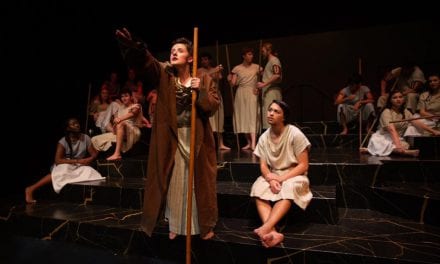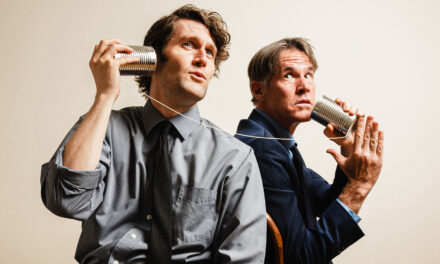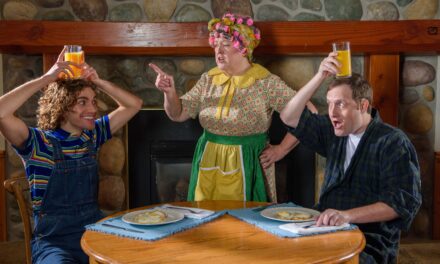SALT LAKE CITY — The Parker Theatre in Salt Lake City is currently presenting the play, The Cat in the Hat, as its latest fair for young audiences. My 9-year-old daughter and I set out on Saturday to view the 1 PM matinee to see just what Dr. Seuss and the famous Cat would be doing in Salt Lake.

Show closes February 22, 2020.
As we came into the theater, we saw the set: a couch in a room with a desk and typewriter, and a few windows and doors that looked rather, well, Seussian. Set designer James B. Parker certainly seemed to have a grasp on what the familiar author’s stories looked like. As the story opens up, Dr. Seuss, played by Bryson Dumas, comes on stage and attempts to put a story to paper, but he is interrupted by a stink in his think, and hilarity ensues. One of the most delightful aspects of this first act was the way that the players brought in the audience interaction, an element that is sometimes seen in all levels of theatre but that has proven to be essential to good theatre for younger audiences. As the character Dr. Seuss works to try and gain the focus he needs to write his story, he uses the children in the audience who grow more and more delighted to be a part of helping shape the stories that is easy to see they know very, very well.
The Parker Theatre has general admission seating, and as a critic, I often like to pick one of the “less desirable” seats. I fell into the joy that is theatre criticism because of a love of theatre, and I spent my younger years finding discount tickets any way I could, thus I’ve viewed many a show from the nosebleed or standing room only. While it is great to get the best seats in the house, I value a director who can cater to all the audience, not just those lucky or well-off enough to have the premium seats. Director Meighan Smith seems to understand that children will be seeing the show from the back and from the sides, and she has found ways to delight all over. My daughter at first thought she would be disappointed when bubbles came across the middle of the audience until one was right over her head, and she was sad when a kite flew on the other side of the room until it then flew directly over her.
As the second act unfolds, it becomes a direct retelling of the famous book The Cat in the Hat. The mischievous cat is played by Tom S. Roche, the young Sally is played by Alina Smith, and the boy is played by John Sandorf. The cast is rounded out by Dumas now playing the scolding Fish, Maddox Thompson playing Thing 1, and Alexis Bitner playing Thing 2. As in Act 1, the set and lighting by Parker are absolutely unmatched in excellence. It was as if someone had opened up my worn copy of Cat in the Hat and projected it on stage. Property design by Larissa Anderson and costume design by Julie Anderson added to this visual to create the perfect scenic makeup with a few added screen projections of key words of exclamation for dramatic effect.

Right to left: Maddox Thompson as Thing 1, Tom S. Roche as Cat in the Hat, and Alexis Bitner as Thing 2. Photo by Parker Theatre.
One of my favorite directorial choices of this production was that of movement speed. Because the words of the story are so familiar, one thing that could make the story so unique was in the speed of telling. At one point the Cat is holding the Fish and stacking many things on his hat until everything comes falling down. At this point, the whole cast begins to move in slow motion, and the movement combined with the lighting and sound, handled well by Missy Stebbing, create a scene so perfect that it does more than recreate the splash on the page. It becomes a new and better memory for that story.
The wild and crazy Thing 1 and 2 by Thompson and Bitner are the stuff of parents’ nightmares and kids’ dreams. The actors’s physical comedy and acrobatic movements were excellent as were their use of the stage and audience spaces. The laughter from the children in the room was infectious and delightful.
The interaction between Alina Smith as Sally and Sandorf as the Boy was so nuanced and well thought-out that I was astounded to discover that Sally is an 8th grade student as credited in her bio. I predict Alina Smith will have a long career ahead of her if she continues to learn from the way she was portraying her characterization in this show.
Of course, the main character played by Roche was a strong balance of innocence and mischief. He was convincing in his desire to have fun yet still lovable enough to forgive some of the largest of mishaps. The wise words of the fish did prevail, and the understandable choices of the children to want to present a clean home to their mother in the end made sense.
In the end, the best criticism that can be given of any theatre for younger audiences is this: my 9-year-old daughter turned to me and said, “When can we come back and see the next show here?”





